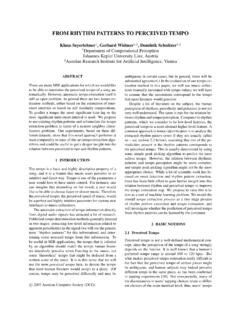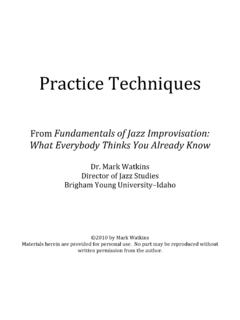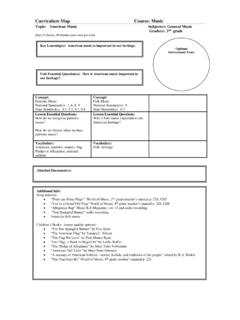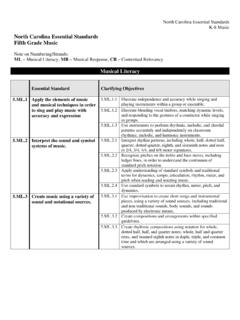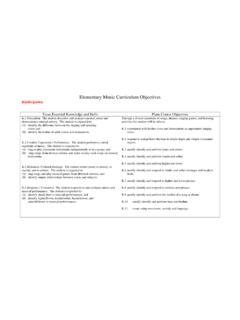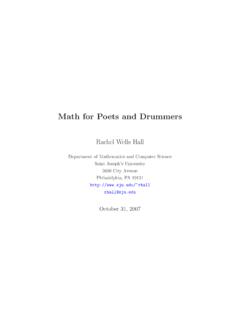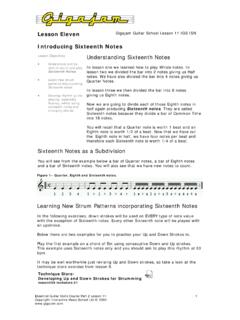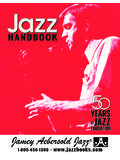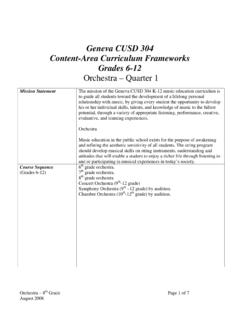Transcription of Music Essential Standards by Grade Span with Student I Can ...
1 Music Essential Standards by Grade Span with Student I Can Statements (Students should be able to accomplish these outcomes by the end of Grades 2, 5, 8, and the Advanced High School Proficiency Level) Processes Skills and Concepts Early Elementary (K-2) Upper Elementary (3-5) Middle Grades (6-8) High School (9-12) Performing singing and playing instruments I can match 2-3 pitch melodies. I can imitate what the teacher sings or plays. I can maintain a steady beat. I can understand changes in Music (soft-loud, high-low, fast-slow). I can use correct position and technique to sing and play instruments. I can produce accurate pitch with expanded ranges. I can sing and play Music independently. I can create harmony with my voice or on instruments. I can sing or play with expression and by applying elemental changes (tempo, dynamics, etc.)
2 I can use the correct techniques to use when singing or playing instruments. I can use characteristic tone and consistent pitch when performing Music alone and collaboratively. I can integrate the fundamental techniques (such as posture, playing position, breath control, fingerings, and bow/stick control) necessary to sing and/or play an instrument. I can interpret expressive elements, including dynamics, timbre, blending, accents, attacks, releases, phrasing, and interpretation, while singing and/or playing a varied repertoire of Music with technical accuracy. I can use refined tone and consistent pitch while performing Music alone and collaboratively. I can use advanced technical and interpretive skills to sing or play difficult literature, which requires the ability to perform Music with complex rhythms and meters, attention to phrasing and interpretation, and subtle dynamic changes.
3 I can interpret expressive elements while singing or playing a diverse repertoire of Music with technical accuracy. I can illustrate well-developed ensemble skills by performing an appropriate part in an ensemble. I can exemplify independence and collaboration as a musician. Interpreting reading and notating Music I can interpret rhythm patterns using standard notation for half and quarter notes, half and quarter rests, and beamed eighth notes. I can interpret three-pitch songs that use traditional Music notation with voice and/or by playing pitched instruments. I can use standard notation to notate half and quarter notes, half and quarter rests, and beamed eighth notes. I can interpret rhythm patterns , including whole, half, dotted half, quarter, dotted quarter, eighth, and sixteenth notes and rests in 2/4, 3/4, 4/4, and 6/8 meter signatures.
4 I can interpret through voice and/or instruments simple pitch notation in the treble clef in major keys. I can recognize pitches on the treble and bass staves, including ledger lines. I can apply understanding of standard symbols and traditional terms for dynamics, tempo, articulation, rhythm , meter, and pitch when reading and notating Music . I can use standard symbols to notate rhythm , meter, pitch, and dynamics. I can interpret standard musical notation for whole, half, quarter, eighth, sixteenth, and dotted note and rest durations in 2/4, 3/4, 4/4, 6/8, 3/8, and alla breve meter signatures. I can interpret, through instrument and/or voice, standard notation symbols in two different clefs, using extended staves. I can use standard symbols for pitch, rhythm , dynamics, tempo, articulation, and expression to notate musical ideas.
5 I can interpret a variety of note and rest durations in simple, compound, and mixed meters. I can interpret at sight standard notation symbols for pitch and rhythm in appropriate clefs, using extended staves and some non-standard notations. I can use standard notation symbols for pitch, rhythm , dynamics, tempo, articulation and expression to notate personal musical ideas and the musical ideas of others. I can analyze how the elements of Music are used, including the use of transpositions and clefs, in works of Music . Creating improvising, arranging, composing Music I can use improvisation to create simple rhythmic and melodic variations on familiar melodies. I can select a variety of traditional and non-traditional sound sources to accompany readings, stories, or dramatizations.
6 I can create rhythm patterns using half and quarter notes, half and quarter rests, and beamed eighth notes in duple and triple meter. I can use improvisation to create short songs and instrumental pieces, using a variety of sound sources, including traditional and non- traditional sounds, body sounds, and sounds produced by electronic means. I can create compositions and arrangements within specified guidelines. I can create rhythmic compositions using notation for whole, dotted half, half, and quarter notes; whole, half and quarter rests; and beamed eighth notes in duple, triple, and common time and which are arranged using a variety of sound sources. I can produce simple rhythmic and melodic improvisations on pentatonic or blues scales, pentatonic melodies, and/or melodies in major keys.
7 I can construct arrangements of simple pieces for voices or instruments other than those for which the pieces were written. I can construct short pieces within specified guidelines ( , a particular style, form, instrumentation, compositional technique), using a variety of traditional and non-traditional sound, notational, and 21st century technological sources. I can use improvisation to create original melodies over given chord progressions, each in a consistent style, meter, and tonality. I can create arrangements of pieces for voices or instruments. I can create original Music using imagination and technical skill in applying the principles of composition. Responding listening to, moving to, analyzing, and evaluating Music and Music performances I can use singing, playing, and/or moving to respond to a variety of musical ideas, prominent musical characteristics, or specific musical events.
8 I can recognize contrasts in Music , such as high/low pitch, loud/soft dynamics, fast/slow tempo, and same/different sections of Music . I can recognize melodic patterns , rhythmic patterns , dynamics, and forms when presented aurally. I can illustrate melodic patterns , dynamics, and forms. I can illustrate audience and participant behavior appropriate for the purpose and setting that Music is performed. I can differentiate various vocal timbres and instruments based on how their sounds are produced. I can interpret through instruments and/or voice the gestures of the conductor, including meter, tempo, dynamics, entrances, cut-offs, and phrasing, when singing and playing Music . I can use Music terminology in explaining Music , including notation, instruments, voices, and performances.
9 I can design a set of criteria for evaluating Music performances and compositions. I can exemplify appropriate behaviors as a participant and observer of Music in relation to the context and style of Music performed. I can identify the sounds of a variety of instruments and voices. I can classify classroom, Western orchestral, and world instruments into categories based on how their sounds are produced. I can illustrate perceptual skills by moving to, answering questions about, and describing aural examples of Music of various styles and cultures. I can interpret the gestures of a conductor when singing or playing an instrument. I can analyze aural musical examples representing diverse genres, styles, and cultures, using appropriate Music terminology. I can identify principles of meter, rhythm , tonality, intervals, chords, and harmonic progressions using appropriate Music terminology in analyses of Music .
10 I can evaluate performances, compositions, and musical ideas using a specified set of criteria (such as tone quality, intonation, blend/ balance, technique, musical effect, interpretation, and diction). I can execute the gestures of the conductor, including meter, tempo, dynamics, entrances, cut-offs, and phrasing, to elicit expressive singing or playing. I can analyze aural examples of Music using correct Music terminology, in terms of how compositional devices and techniques are used to structure compositions. I can analyze musical works using correct Music terminology, in terms of the interaction of elements that make the works unique, interesting, and expressive. I can critique Music in terms of aesthetic qualities, including how Music is used to evoke feelings and emotions.
